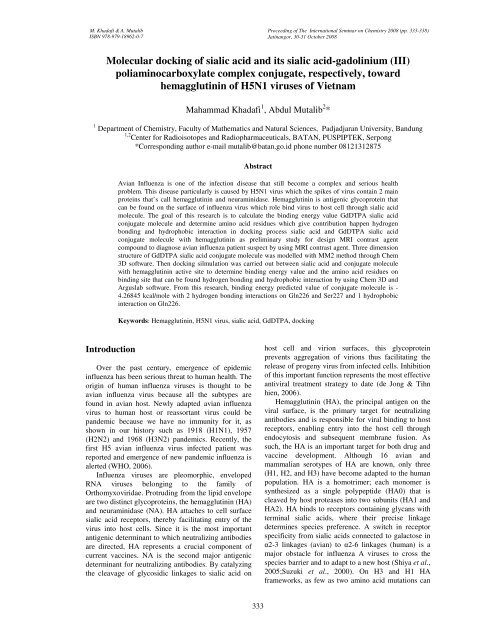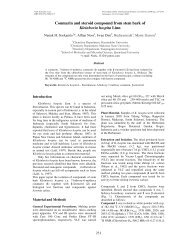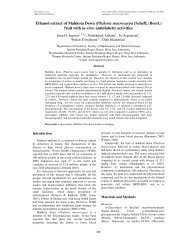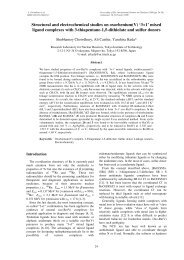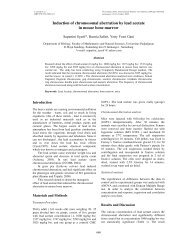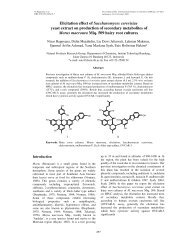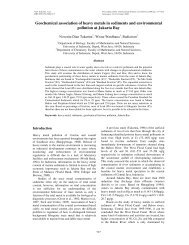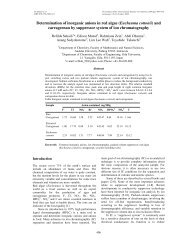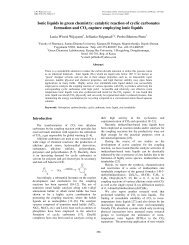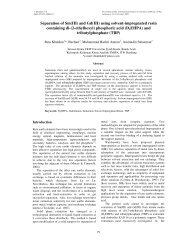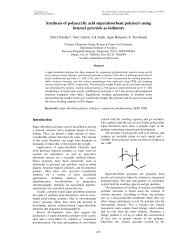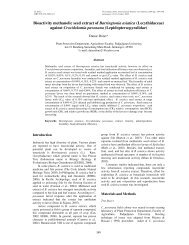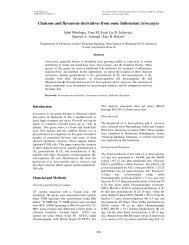Molecular docking of sialic acid and its sialic acid-gadolinium (III ...
Molecular docking of sialic acid and its sialic acid-gadolinium (III ...
Molecular docking of sialic acid and its sialic acid-gadolinium (III ...
Create successful ePaper yourself
Turn your PDF publications into a flip-book with our unique Google optimized e-Paper software.
M. Khadafi & A. Mutalib Proceeding <strong>of</strong> The International Seminar on Chemistry 2008 (pp. 333-338)ISBN 978-979-18962-0-7Jatinangor, 30-31 October 2008<strong>Molecular</strong> <strong>docking</strong> <strong>of</strong> <strong>sialic</strong> <strong>acid</strong> <strong>and</strong> <strong>its</strong> <strong>sialic</strong> <strong>acid</strong>-<strong>gadolinium</strong> (<strong>III</strong>)poliaminocarboxylate complex conjugate, respectively, towardhemagglutinin <strong>of</strong> H5N1 viruses <strong>of</strong> VietnamMahammad Khadafi 1 , Abdul Mutalib 2 *1 Department <strong>of</strong> Chemistry, Faculty <strong>of</strong> Mathematics <strong>and</strong> Natural Sciences, Padjadjaran University, B<strong>and</strong>ung1,2 Center for Radioisotopes <strong>and</strong> Radiopharmaceuticals, BATAN, PUSPIPTEK, Serpong*Corresponding author e-mail mutalib@batan.go.id phone number 08121312875AbstractAvian Influenza is one <strong>of</strong> the infection disease that still become a complex <strong>and</strong> serious healthproblem. This disease particularly is caused by H5N1 virus which the spikes <strong>of</strong> virus contain 2 mainproteins that’s call hemagglutinin <strong>and</strong> neuraminidase. Hemagglutinin is antigenic glycoprotein thatcan be found on the surface <strong>of</strong> influenza virus which role bind virus to host cell through <strong>sialic</strong> <strong>acid</strong>molecule. The goal <strong>of</strong> this research is to calculate the binding energy value GdDTPA <strong>sialic</strong> <strong>acid</strong>conjugate molecule <strong>and</strong> determine amino <strong>acid</strong> residues which give contribution happen hydrogenbonding <strong>and</strong> hydrophobic interaction in <strong>docking</strong> process <strong>sialic</strong> <strong>acid</strong> <strong>and</strong> GdDTPA <strong>sialic</strong> <strong>acid</strong>conjugate molecule with hemagglutinin as preliminary study for design MRI contrast agentcompound to diagnose avian influenza patient suspect by using MRI contrast agent. Three dimensionstructure <strong>of</strong> GdDTPA <strong>sialic</strong> <strong>acid</strong> conjugate molecule was modelled with MM2 method through Chem3D s<strong>of</strong>tware. Then <strong>docking</strong> silmulation was carried out between <strong>sialic</strong> <strong>acid</strong> <strong>and</strong> conjugate moleculewith hemagglutinin active site to determine binding energy value <strong>and</strong> the amino <strong>acid</strong> residues onbinding site that can be found hydrogen bonding <strong>and</strong> hydrophobic interaction by using Chem 3D <strong>and</strong>Arguslab s<strong>of</strong>tware. From this research, binding energy predicted value <strong>of</strong> conjugate molecule is -4.26845 kcal/mole with 2 hydrogen bonding interactions on Gln226 <strong>and</strong> Ser227 <strong>and</strong> 1 hydrophobicinteraction on Gln226.Keywords: Hemagglutinin, H5N1 virus, <strong>sialic</strong> <strong>acid</strong>, GdDTPA, <strong>docking</strong>IntroductionOver the past century, emergence <strong>of</strong> epidemicinfluenza has been serious threat to human health. Theorigin <strong>of</strong> human influenza viruses is thought to beavian influenza virus because all the subtypes arefound in avian host. Newly adapted avian influenzavirus to human host or reassortant virus could bep<strong>and</strong>emic because we have no immunity for it, asshown in our history such as 1918 (H1N1), 1957(H2N2) <strong>and</strong> 1968 (H3N2) p<strong>and</strong>emics. Recently, thefirst H5 avian influenza virus infected patient wasreported <strong>and</strong> emergence <strong>of</strong> new p<strong>and</strong>emic influenza isalerted (WHO, 2006).Influenza viruses are pleomorphic, envelopedRNA viruses belonging to the family <strong>of</strong>Orthomyxoviridae. Protruding from the lipid envelopeare two distinct glycoproteins, the hemagglutinin (HA)<strong>and</strong> neuraminidase (NA). HA attaches to cell surface<strong>sialic</strong> <strong>acid</strong> receptors, thereby facilitating entry <strong>of</strong> thevirus into host cells. Since it is the most importantantigenic determinant to which neutralizing antibodiesare directed, HA represents a crucial component <strong>of</strong>current vaccines. NA is the second major antigenicdeterminant for neutralizing antibodies. By catalyzingthe cleavage <strong>of</strong> glycosidic linkages to <strong>sialic</strong> <strong>acid</strong> onhost cell <strong>and</strong> virion surfaces, this glycoproteinprevents aggregation <strong>of</strong> virions thus facilitating therelease <strong>of</strong> progeny virus from infected cells. Inhibition<strong>of</strong> this important function represents the most effectiveantiviral treatment strategy to date (de Jong & Tihnhien, 2006).Hemagglutinin (HA), the principal antigen on theviral surface, is the primary target for neutralizingantibodies <strong>and</strong> is responsible for viral binding to hostreceptors, enabling entry into the host cell throughendocytosis <strong>and</strong> subsequent membrane fusion. Assuch, the HA is an important target for both drug <strong>and</strong>vaccine development. Although 16 avian <strong>and</strong>mammalian serotypes <strong>of</strong> HA are known, only three(H1, H2, <strong>and</strong> H3) have become adapted to the humanpopulation. HA is a homotrimer; each monomer issynthesized as a single polypeptide (HA0) that iscleaved by host proteases into two subun<strong>its</strong> (HA1 <strong>and</strong>HA2). HA binds to receptors containing glycans withterminal <strong>sialic</strong> <strong>acid</strong>s, where their precise linkagedetermines species preference. A switch in receptorspecificity from <strong>sialic</strong> <strong>acid</strong>s connected to galactose inα2-3 linkages (avian) to α2-6 linkages (human) is amajor obstacle for influenza A viruses to cross thespecies barrier <strong>and</strong> to adapt to a new host (Shiya et al.,2005;Suzuki et al., 2000). On H3 <strong>and</strong> H1 HAframeworks, as few as two amino <strong>acid</strong> mutations can333
M. Khadafi & A. Mutalib Proceeding <strong>of</strong> The International Seminar on Chemistry 2008 (pp. 333-338)Jatinangor, 30-31 October 2008switch human <strong>and</strong> avian receptor specificity (Stevenset al., 2006).Gadolinium ion (Gd 3+ ) is very suitable for MRIcontrast agent compound because <strong>of</strong> paramagneticproperties <strong>and</strong> stabilization <strong>of</strong> <strong>its</strong> chelat. Gadoliniumcomplex molecules are paramagnetic complex that canbe used widely as MRI contrast agent compound.Some factors which cause Gd complex suitable forthis application are Gd 3+ ion have highestparamagnetic properties because <strong>of</strong> seven unpairelectron in 4f 7 valence shell, have longest electronicrelaxation time, <strong>and</strong> can form stable chelate that cancoordinate with two water compound (inner-spherecoordination) (Aime et al., 2002). Some example <strong>of</strong>Gd 3+ complex compounds that have been accepted inclinical study are Gd-DTPA, Gd-BOPTA, Gd-DOTA(Jacques & Desreux, 2002).Recently, avian influenza viruses have beeninfected human as host cell <strong>and</strong> cause many suspectedpatient bird flu died in large number. For diagnose thesuspected patient bird flu, some hospital are still usinglaboratory prosedure usually performed byimmunochromatographic or immun<strong>of</strong>luorescentdetection <strong>of</strong> influenza virus antigens, or reversetranscriptase polymerase chain reaction (RT-PCR)detection <strong>of</strong> viral nucleic <strong>acid</strong>s in respiratory specimen(Hien et al., 2004). This method is takes a lot <strong>of</strong> time(4 to 5 days) to have complete diagnose. So, we studythe stabilization <strong>and</strong> binding affinity <strong>of</strong> GdDTPA<strong>sialic</strong> <strong>acid</strong> conjugate compound throughcomputational chemistry approach for novel MRIcontrast agent compound to diagnose suspectedhuman bird flu by using MRI contrast agent.<strong>of</strong> grid resolution <strong>and</strong> <strong>docking</strong> method in ArgusLab 4.Docking <strong>of</strong> lig<strong>and</strong> <strong>sialic</strong> <strong>acid</strong> <strong>and</strong> conjugate moleculeinto the HA (PDB:2FK0) receptor binding site wasperformed with grid resoution <strong>and</strong> <strong>docking</strong> methodresult from validation <strong>docking</strong> method. Bindingenergy (∆G) result was compared <strong>and</strong> the bestconformation result <strong>of</strong> both lig<strong>and</strong>s were analyzed thehydrogen bonding <strong>and</strong> hydrophobic interaction toidentify spesific contact between lig<strong>and</strong>s <strong>and</strong> HA.Hardware <strong>and</strong> S<strong>of</strong>tware. Cambridges<strong>of</strong>t Chem 3D 8was used for molecular modelling. Cambridges<strong>of</strong>tChem Draw 8 was used for create <strong>gadolinium</strong>complex structure. Parameter files GdDTPAmolecular mechanic (MM2) calculation wasperformed on Chem 3D 8. Windows Xp Sp 3 wasused as operating system. Arguslab 4.0.1 was used for<strong>docking</strong> simulation <strong>and</strong> analysis interaction.Results <strong>and</strong> DiscussionModeling <strong>of</strong> <strong>sialic</strong> <strong>acid</strong> – GdDTPA conjugatemoleculeComplex struture <strong>of</strong> CHx-A”-Gd-DTPAcompound was drawed with chem draw s<strong>of</strong>tware tocreate the 2 dimension structure <strong>of</strong> GdDTPA. The 2dimension structure <strong>of</strong> GdDTPA compound wasexported to 3 dimension structure by using chem 3Ds<strong>of</strong>tware. The result compound <strong>of</strong> GdDTPA structurecomplex can be seen in Fig.1.Materials <strong>and</strong> MethodsModeling <strong>of</strong> <strong>sialic</strong> <strong>acid</strong> <strong>and</strong> <strong>sialic</strong> <strong>acid</strong> – GdDTPAconjugate molecule.The native <strong>sialic</strong> <strong>acid</strong> molecule was modeled byconjugate the 3D structure <strong>of</strong> CHx-A”-Gd-DTPAusing Chem 3D 8 s<strong>of</strong>tware. Structure <strong>of</strong> <strong>sialic</strong> <strong>acid</strong> <strong>and</strong>conjugate molecule GdDTPA – <strong>sialic</strong> <strong>acid</strong> were doneminimisation energy job using molecular mechanic(MM2) method. Then, conjugate molecule GdDTPA– <strong>sialic</strong> <strong>acid</strong> was modified with replaced the electrondonor atom (N atom) <strong>of</strong> conjugate molecule to dummyatom (Du atom). Both <strong>of</strong> structure minimisation resultwere calculate the steric energy summary by usingcompute properties job <strong>and</strong> done the overlay structurebetween those <strong>of</strong> structures. The parameter resultfrom minimisation i.e. length bond <strong>and</strong> angel bondwere calculated the root mean square (RMS) value t<strong>of</strong>ind out the deviation value between both structures.Then, validation <strong>docking</strong> method was carried out by<strong>docking</strong> the native <strong>sialic</strong> <strong>acid</strong> into receptor bimdingsite (RBS) <strong>of</strong> HA by using ArgusLab 4 s<strong>of</strong>tware.Validation method was done to compare the variationFigure 1 The 3D strucure <strong>of</strong> GdDTPA complexcompound.The native structure <strong>of</strong> <strong>sialic</strong> <strong>acid</strong> was separated fromthe protein HA co – crystallize structure. Then <strong>sialic</strong><strong>acid</strong> structure was conjugated with GdDTPA structurethrough connecting the Nitrogen atom <strong>of</strong> imine tailGdDTPA structure to Carbon atom 1 (C-1) <strong>of</strong> <strong>sialic</strong><strong>acid</strong> structure which have been removed the hydroxyltail (-OH) bind to C-1 atom before. The result <strong>of</strong>conjugate structure <strong>sialic</strong> <strong>acid</strong> – GdDTPA is showedin Fig.2.334
M. Khadafi & A. Mutalib Proceeding <strong>of</strong> The International Seminar on Chemistry 2008 (pp. 333-338)Jatinangor, 30-31 October 2008Figure 2 Conjugate structure <strong>of</strong> <strong>sialic</strong> <strong>acid</strong> <strong>and</strong> <strong>sialic</strong><strong>acid</strong> – GdDTPA compound.Then, conjugate structure <strong>and</strong> <strong>sialic</strong> <strong>acid</strong> nativestructure were done minimisation energy job usingmolecular mechanic MM2 method to make the stableconformation <strong>of</strong> both structures based onintramolecular interaction among the atomscomposition <strong>of</strong> both molecules. The result <strong>of</strong>minimisation energy was stable conformationstructures <strong>of</strong> <strong>sialic</strong> <strong>acid</strong> <strong>and</strong> conjugate molecule as weseen in Fig.3.other <strong>and</strong> also for Oxygen atoms no. 2, 3, 4, 5 <strong>and</strong>Nitrogen atom no. 10. Overall, the conformation <strong>of</strong><strong>sialic</strong> <strong>acid</strong> structure from conjugate molecule is closeto <strong>sialic</strong> <strong>acid</strong> native structure. This result is agree withcalculation result <strong>of</strong> RMS (Root Mean Square) lengthbond <strong>and</strong> angle bond. The RMS <strong>of</strong> length bond is0.004685 <strong>and</strong> angle bond is 1.1.9265. This calculationresult show that the RMS value <strong>of</strong> length bond <strong>and</strong>angle bond are small. It’s mean that both <strong>sialic</strong> <strong>acid</strong>structures have close conformation structure. So, thereis a little bit deviation between both <strong>sialic</strong> <strong>acid</strong>structures.Figure 4 Overlay structure result between <strong>sialic</strong> <strong>acid</strong>native structure (red) <strong>and</strong> <strong>sialic</strong> <strong>acid</strong>conjugate molecule (green).(a)After that, both <strong>sialic</strong> <strong>acid</strong> structures were calculatedthe steric energy summary to know the stablization <strong>of</strong>both compound. The calculations result <strong>of</strong> stericenergy summary are shown in Tab.1.Tabel 1 The sum <strong>of</strong> steric energy <strong>and</strong> <strong>its</strong>composition energy(b)Figure 3 The stable confomation <strong>of</strong> conjugatemolecule (a) <strong>and</strong> <strong>sialic</strong> <strong>acid</strong> (b) after donethe minimisation energy.Conjugate molecule GdDTPA – <strong>sialic</strong> <strong>acid</strong> wasmodified with replacing the electron donor atom(Nitrogen atom) to dummy atom <strong>and</strong> remove theGdDTPA structure complex. This procedure was doneto know how much the deviation <strong>of</strong> <strong>sialic</strong> <strong>acid</strong>conformation <strong>of</strong> conjugate molecule to native <strong>sialic</strong><strong>acid</strong> that have been done minimisation energy before.The modified conjugate molecule <strong>and</strong> <strong>sialic</strong> <strong>acid</strong>structure were done overlay to know the differentconformation <strong>of</strong> <strong>sialic</strong> <strong>acid</strong> in conjugate molecule.From the overlay structure, we see that there is a littledifferent conformation among those structures whichis showed in Fig.4. The atoms Carbon no. 11, 12, 13,14, 15, 16, 17, 18, <strong>and</strong> 20 show that overlapped eachComposition <strong>of</strong>steric energyConjugate<strong>sialic</strong> <strong>acid</strong>(kcal/mole)Native<strong>sialic</strong> <strong>acid</strong>(kcal/mole)Stretch 5.7070 5.6029Bend 24.0232 28.9564Stretch-Bend 0.9994 1.2446Torsion 11.6823 10.7191Non-1,4 VDW -8.7975 -10.77161,4 VDW 15.6697 13.6970Dipole/Dipole -3.8840 -6.2429Total 45.4001 43.2056The result indicate that total steric energy <strong>of</strong> conjugatemolecule is less stable than native <strong>sialic</strong> <strong>acid</strong>, because<strong>of</strong> calculation show that the steric energy total <strong>of</strong> <strong>sialic</strong><strong>acid</strong> conjugate molecule (45.4001 kcal/mole) is biggerthan <strong>sialic</strong> <strong>acid</strong> native structure (43.2056 kcal/mole).Value <strong>of</strong> steric energy composition for bend energy,non-1,4 VDW energy, <strong>and</strong> dipole/dipole energy showbig differences. This result impact on the imperfectresult <strong>of</strong> the overlay structure between both <strong>sialic</strong> <strong>acid</strong>molecules.335
M. Khadafi & A. Mutalib Proceeding <strong>of</strong> The International Seminar on Chemistry 2008 (pp. 333-338)Jatinangor, 30-31 October 2008Validation <strong>docking</strong> method in ArgusLab s<strong>of</strong>tware.Validation <strong>docking</strong> in ArgusLab was carriedout for validate the <strong>docking</strong> method <strong>and</strong> the variation<strong>of</strong> grid resolution value in <strong>docking</strong> simulation withArgusLab. This procedure was used to know howdoes the effect <strong>of</strong> the variation <strong>docking</strong> method <strong>and</strong>grid resolution value in the result <strong>of</strong> <strong>docking</strong>simulation with ArgusLab. We compare the <strong>docking</strong>method in ArgusLab between ArgusDock <strong>and</strong>GADock method <strong>and</strong> also the variation <strong>of</strong> gridresolution (0.1 ; 0.15 ; 0.2 ; 0.25 ; 0.3 ; 0.35 ; 0.4 Ǻ).Both <strong>docking</strong> methods (ArgusDock <strong>and</strong> GADock)have different approximation. For ArgusDock, the<strong>docking</strong> method use structure <strong>and</strong> lig<strong>and</strong>approximation which is <strong>docking</strong> mechanism directedto limited position only. Meanwhile, GADock useapproximation which lig<strong>and</strong> is <strong>docking</strong> directed to allpossible position in receptor (protein) (9). Thisvalidation prosedure base on the different value <strong>of</strong>RMSD (Root Mean Square Deviation) between native<strong>sialic</strong> <strong>acid</strong> lig<strong>and</strong> <strong>and</strong> copy <strong>sialic</strong> <strong>acid</strong> lig<strong>and</strong> whichdock into the receptor binding site <strong>of</strong> hemagglutinin.From this validation, we can get the best <strong>docking</strong>method <strong>and</strong> value <strong>of</strong> grid resolution based on thesmallest value <strong>of</strong> RMSD. In Tab.2, we can see theresult <strong>of</strong> validation <strong>docking</strong> method.Tabel 2 The result <strong>of</strong> validation <strong>docking</strong> method inArgusLab 4.RMSD value <strong>of</strong>Grid resolution<strong>docking</strong> method(Ǻ)GADock ArgusDock0.1 0.963723 4.1462260.15 1.270897 4.2479860.2 0.614733 4.3979560.25 0.867363 4.2468130.3 1.046308 4.4035480.35 0.711158 4.3913810.4 1.024216 4.458099The <strong>docking</strong> validation method is valid if the RMSDvalue is not more than 2.0000. From this result, wecan conclude that the smallest RMSD value was0.614733. GADock <strong>docking</strong> method has smallerRMSD value than ArgusDock. So, GADock is muchbetter used in <strong>docking</strong> prosedure than ArgusDock.The variation value <strong>of</strong> grid resolution show that 0.2 Ǻgive the smallest RMSD value in GADock <strong>docking</strong>method. In this case, we use GADock as <strong>docking</strong>method <strong>and</strong> 0.2 Ǻ as the value <strong>of</strong> grid resolution forrunning <strong>docking</strong> simulation <strong>sialic</strong> <strong>acid</strong> native structure<strong>and</strong> <strong>sialic</strong> <strong>acid</strong> conjugate molecule into the receptorbinding site <strong>of</strong> protein hemagglutinin.Docking simulation <strong>and</strong> interaction analysis <strong>of</strong> <strong>sialic</strong><strong>acid</strong> native structure with protein hemagglutininDocking simulation between <strong>sialic</strong> <strong>acid</strong> nativestructure <strong>and</strong> protein hemagglutinin were carried outwith ArgusLab s<strong>of</strong>tware. The parameter <strong>of</strong> calculationwas using parameter data from validation <strong>docking</strong>result. In this case, we use protein hemagglutininVietnam (PDB code:2FK0) which is the host sel comefrom human bird flu case. The result <strong>of</strong> <strong>docking</strong>simulation (in Fig.5a) show that the best pose <strong>of</strong>native <strong>sialic</strong> <strong>acid</strong> structure with predicted bindingenergy value (∆G) -3.5443 kcal/mole. This <strong>docking</strong>simulation create 13 poses <strong>of</strong> native <strong>sialic</strong> <strong>acid</strong>structure <strong>and</strong> the best pose indicate that <strong>sialic</strong> <strong>acid</strong>give the best conformation which fit into receptorbinding site <strong>of</strong> protein hemagglutinin. We also analysethe interaction between lig<strong>and</strong> native <strong>sialic</strong> <strong>acid</strong> <strong>and</strong>receptor binding site <strong>of</strong> hemagglutinin protein.From the Fig.5b, we see that there are 4 hydrogenbonding <strong>and</strong> 6 hydrophobic interactions which can beformed between <strong>sialic</strong> <strong>acid</strong> <strong>and</strong> hemagglutinin.Hydrogen bonding interactions (red line) are involved2 amino <strong>acid</strong> residues i.e. Glu190 <strong>and</strong> His 193.Meanwhile, hydrophobic interctions (blue line) areinvolved 3 amino <strong>acid</strong> residues, that is Leu 194, Gly228, <strong>and</strong> Ser 227. Many hydrophobic interactions withprotein hemagglutinin this indicate the <strong>sialic</strong> <strong>acid</strong>native structure can’t get into the active site <strong>of</strong> proteinhemagglutinin. Hydrogen bonding that is formedbetween <strong>sialic</strong> <strong>acid</strong> <strong>and</strong> hemagglutinin have a weakinteraction <strong>and</strong> long distance. Overall, from the energy<strong>and</strong> geometry analysis, the interaction between <strong>sialic</strong><strong>acid</strong> native strcuture <strong>and</strong> protein hemagglutinin showweak interactions.Docking simulation <strong>and</strong> interaction analysis <strong>of</strong> <strong>sialic</strong><strong>acid</strong> conjugate structure with protein hemagglutininFor <strong>sialic</strong> <strong>acid</strong> conjugate structure, <strong>docking</strong>simulation used the same parameter data from <strong>docking</strong>validation parameter that have been done before.The different procedure from <strong>docking</strong> <strong>sialic</strong> <strong>acid</strong>native structure is treatment <strong>of</strong> lig<strong>and</strong>. We subjectedlig<strong>and</strong> as rigid lig<strong>and</strong> For <strong>sialic</strong> <strong>acid</strong> conjugatestructure. Beside that, <strong>sialic</strong> <strong>acid</strong> native structure istreated as flexible lig<strong>and</strong>. This was done in order to<strong>sialic</strong> <strong>acid</strong> conjugate molecule can’t change <strong>its</strong>conformation. So, the <strong>docking</strong> simulation was runningwith rigid – rigid <strong>docking</strong> method. We can see inFig.6a, predicted binding energy value (∆G) from<strong>docking</strong> simulation is about -4.26845 kcal/mole. Thisvalue was less than from <strong>docking</strong> simulation <strong>of</strong> <strong>sialic</strong><strong>acid</strong> native structure. From energy analysis, it showthat <strong>sialic</strong> <strong>acid</strong> conjugate molecule could bind tightlyin hemagglutinin receptor binding site <strong>and</strong> also couldshift <strong>sialic</strong> <strong>acid</strong> native structure.336
M. Khadafi & A. Mutalib Proceeding <strong>of</strong> The International Seminar on Chemistry 2008 (pp. 333-338)Jatinangor, 30-31 October 2008(a)(b)Figure 5 Result <strong>of</strong> <strong>docking</strong> simulation between <strong>sialic</strong> <strong>acid</strong> native structure <strong>and</strong> protein hemagglutinin. (a)Thebest pose <strong>of</strong> <strong>sialic</strong> <strong>acid</strong> with binding energy value, (b) interaction analysis show red line is hydrogenbonding <strong>and</strong> blue line is hydrophobic interaction.The interaction analysis (Fig.6b) also show that <strong>sialic</strong><strong>acid</strong> conjugate molecule can form 2 hydrogen bonding<strong>and</strong> 1 hydrophobic interaction with amino <strong>acid</strong>residues in hemagglutinin receptor binding site.Hydrogen bonding interactions are involved 2 amino<strong>acid</strong> residues Gln 226 <strong>and</strong> Ser 227 which is Gln 226have strong interaction (2.473235 Å) with <strong>sialic</strong> <strong>acid</strong>conjugate molecule. Experiment result from Taiwanresearcher show Gln 226 is a critical amino <strong>acid</strong>residue that can make stronger interaction with SA-α-2, 3-Gal than SA-α-2, 6-Gal (Li & Wang, 2006).Hydrophobic interaction only can form 1 interactionwith Gln 226 amino <strong>acid</strong>. This interaction indicate<strong>sialic</strong> <strong>acid</strong> conjugate molecule can get intohemagglutinin active site. Because from hydrophobicinteraction only show fewer interaction than <strong>sialic</strong> <strong>acid</strong>native structure. This interaction analysis can beconcluded that <strong>sialic</strong> <strong>acid</strong> conjugate molecule bindtightly than <strong>sialic</strong> <strong>acid</strong> native strucutre.Figure 6 Result <strong>of</strong> <strong>docking</strong> simulation between <strong>sialic</strong> <strong>acid</strong> conjugatemolecule <strong>and</strong> protein hemagglutinin. (a)Thebest pose <strong>of</strong> <strong>sialic</strong> <strong>acid</strong> with binding energy value, (b) interaction analysis show red line is hydrogenbonding <strong>and</strong> blue line is hydrophobic interaction.337
M. Khadafi & A. Mutalib Proceeding <strong>of</strong> The International Seminar on Chemistry 2008 (pp. 333-338)Jatinangor, 30-31 October 2008ConclusionsIn summary, we have determined how <strong>sialic</strong> <strong>acid</strong>native structure <strong>and</strong> <strong>sialic</strong> <strong>acid</strong> conjugate moleculebind with hemagglutinin H5N1 virus using molecularmechanic (MM2) calculation <strong>and</strong> molecular <strong>docking</strong>simulation. Given the results presented in this report,it indicates that the <strong>sialic</strong> <strong>acid</strong> conjugate molecule hasstrong hydrogen bond interactions whereas <strong>sialic</strong> <strong>acid</strong>native structure only shows weak interactions. Most <strong>of</strong>the difference arise from interaction with residue Gln226 amino <strong>acid</strong> that have strong hydrogwn bondingwith <strong>sialic</strong> <strong>acid</strong> conjugate molecule. Fromhydrophobic interactions, <strong>sialic</strong> <strong>acid</strong> conjugatemolecule show only a few interaction with amino <strong>acid</strong>residues. This show that <strong>sialic</strong> <strong>acid</strong> conjugatemolecule can be get into the active site <strong>of</strong>hemagglutinin protein. So, we can conclude <strong>sialic</strong> <strong>acid</strong>– GdDTPA conjugate molecule can shift the nativestructure <strong>of</strong> <strong>sialic</strong> <strong>acid</strong> <strong>and</strong> also this conjugatemolecule can be suggested as MRI contrast agentcompound for diagnose suspected human bird fludisease.AcknowledgementsWe thank Dr. Abdul Mutalib for his idea <strong>and</strong>knowledge, Dr. rer. nat Iwan Hastiawan for hisencourage to finish this research, M. Yusuf, S. Si. forhis knowledge <strong>and</strong> guidedance, Rustaman, M. Si. forhelpful comment <strong>and</strong> contunous support, <strong>and</strong>Departement <strong>of</strong> Chemistry Padjadjaran University foreducational support.ReferencesAime, S., Dastru, W., Crich, S. G., Gianolino, E., &Mainero, V. 2002. Biopolimers (Peptida Science).Innovative Magnetic Resonance ImagingDiagnostic Agents Based on Paramagnetic Gd(<strong>III</strong>)Complexes. 66: 419-428.Hien TT, de Jong M, Farrar J. 2004. Avianinfluenza—a challenge to global health carestructures. N Engl J Med.351:2363 – 2365.Jacques, V. <strong>and</strong> Desreux, J.F. 2002. Topics In CurentChemistry. New Classes Of MRI Contrast Agent.Springer-Verlag. Berlin.K. Shinya, M. Hatta, S. Yamada, A. Takada, S.Watanabe, P.Halfmann, T. Horimoto, G.Neumann, J.H. Kim, W. Lim, Y. Guan, M. Peiris,M. Kiso, T. Suzuki, Y. Suzuki, Y. Kawaoka. 2005.Characterization <strong>of</strong> a human H5N1 influenza Avirus isolated in 2003, J. Virol.79:9926–9932Li, M <strong>and</strong> Bingie Wang. 2006. Computaional Study <strong>of</strong>H5N1 Hemagglutinin Binding With SA-a-2,6-Gal<strong>and</strong> SA-a-2,6-Gal. J. Biochem & Biophysical.347:662 – 668.M.D. de Jong <strong>and</strong> Tran Tinh Hien. 2006. AvianInfluenza A (H5N1) J <strong>of</strong> Clinical Virology 35:2-13.Stevens, J, Ola Blixt, Terrence M. Tumpey, Jeffery K.Taubenberger, James C. Paulson, Ian A. Wilson.2006. Structure <strong>and</strong> Receptor Specificity <strong>of</strong> theHemagglutinin from an H5N1 Influenza Virus.J. Science. 312: 404 – 410.Suzuki, Y., Ito, T., Suzuki, T., Holl<strong>and</strong> Jr., R.E.,Chambers, T.M., Kiso, M., Ishida, H., Kawaoka,Y. 2000. Sialic <strong>acid</strong> species as a determinant <strong>of</strong>the host range <strong>of</strong> influenza A viruses. J. Virol.74:11825–11831.The World Health Organization (WHO) Web site.2006. (www.who.int/en/).338


